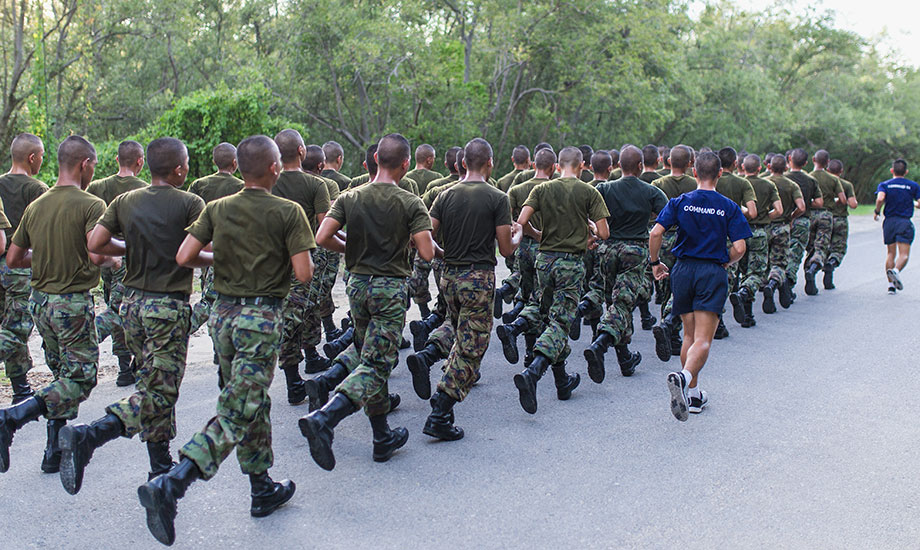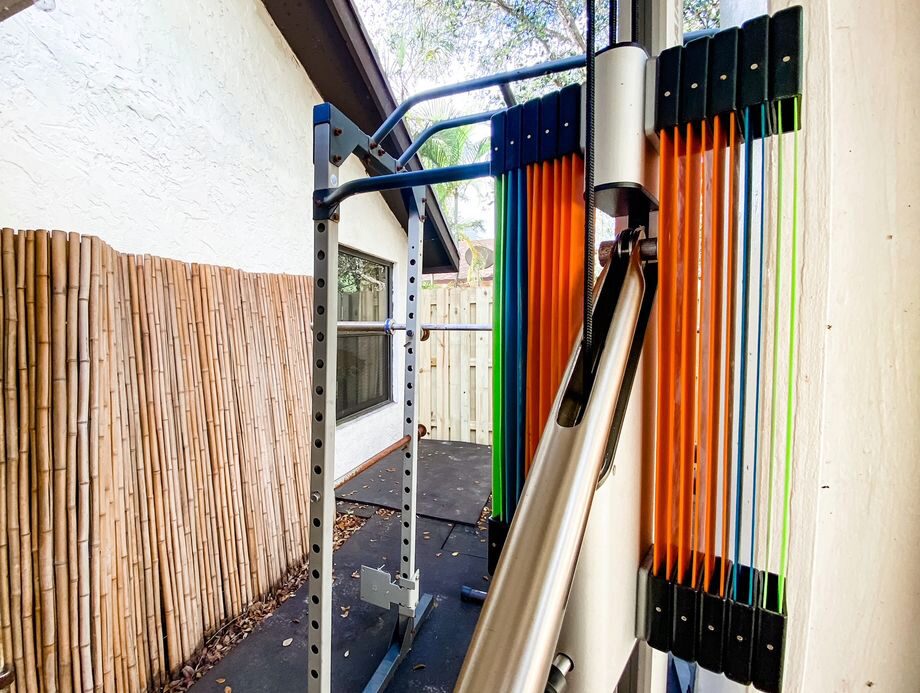Becoming a Navy SEAL is an honor.
The title signifies excellence, but you must be in peak physical condition and exhibit mental fortitude, poise, and all-around toughness to earn the privilege to wear the Trident insignia.
Whether it’s your dream to join the ranks of the U.S. Navy’s elite special ops force, or you simply strive to become the best version of yourself in all aspects, training like a Navy SEAL is a great way to gain strength, improve muscle size and endurance, enhance cardiovascular capacity, and achieve an overall higher fitness level.
RELATED: Cardiovascular Exercises
If you’re ready to train like the best of the best, check out our Navy SEAL workout now!
Medical disclaimer: This article is intended for educational and informational purposes only. It is not intended as a substitute for medical advice. For health advice, contact a licensed healthcare provider.
Understanding Navy SEAL Training
Military service members are faced with adversity daily, so starting out with a strong fitness foundation will only help you succeed if you are interested in serving in the armed forces.
Being fit gives you an advantage in boot camp, as well as subsequent military training programs. To become a Navy SEAL, an officer is required to complete a 24-week program called BUD/S, or “Basic Underwater Demolition/SEAL.”
BUD/S training will challenge and test candidates regularly to ensure their physical fitness, mental toughness, stamina, and leadership skills are improving.
RELATED: The 8 Best Conditioning Workouts
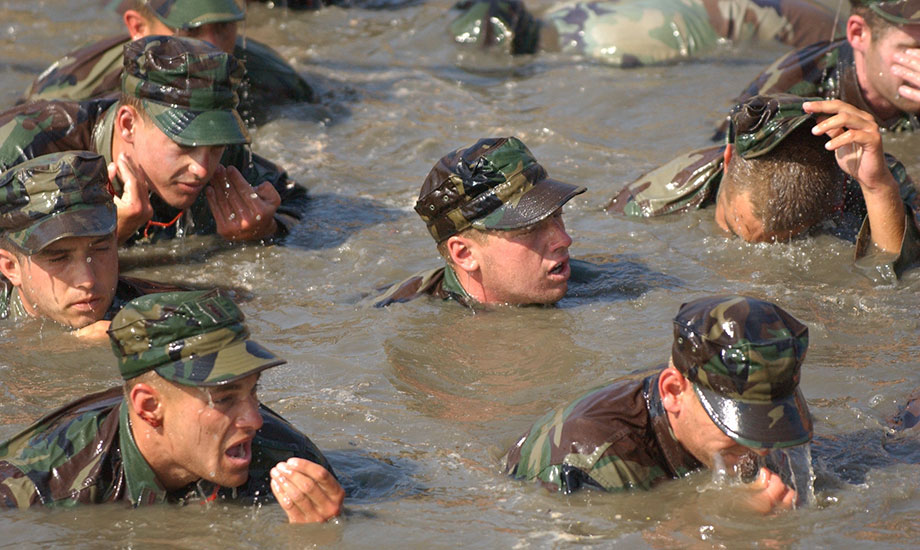
Candidates who are unable to meet the minimum benchmark are expelled immediately. Approximately 70% to 85% of BUD/S candidates do not complete the training.
That’s not all; BUD/S graduates must also complete a basic parachutist course, a 26-week SEAL Qualification Program, and a six-month SEAL-specific Special Operations Tactical Medic course.
Needless to say, it requires a superior fitness level to succeed throughout the Navy SEAL pipeline, and it all starts with completing the BUD/S entrance exam.
Navy SEAL Entrance Exam
The BUD/S entrance exam requires you to complete a PST, or Physical Screening Test, in order to enroll. You’ll be required to demonstrate strong swimming and running abilities, as well as excellent proficiency with calisthenic exercises such as push-ups, pull-ups, and sit-ups.
Specifically, you will be required to:
- Swim 500 yards in under 12 minutes and 30 seconds
- Perform at least 50 push-ups in under 2 minutes
- Perform at least 50 sit-ups in under 2 minutes
- Perform at least 10 pull-ups
- Run 1.5 miles in under 10 minutes and 30 seconds
RELATED: Upper-Ab Workouts
You will receive minimal rest between exercises, and must complete the swimming portion using breaststroke or sidestroke only. Freestyle and backstroke are prohibited.
How to Prepare for Navy SEAL Training
If you want to stand your best chance of being accepted into U.S. Navy SEAL training, you will need to up the ante during your training sessions immediately.
To best prepare for Navy SEAL training, the Navy recommends using the official Naval Special Warfare Physical Training Guide1, which provides a “tailorable 26-week training plan that should help a person with average fitness prepare for training and avoid injury.”
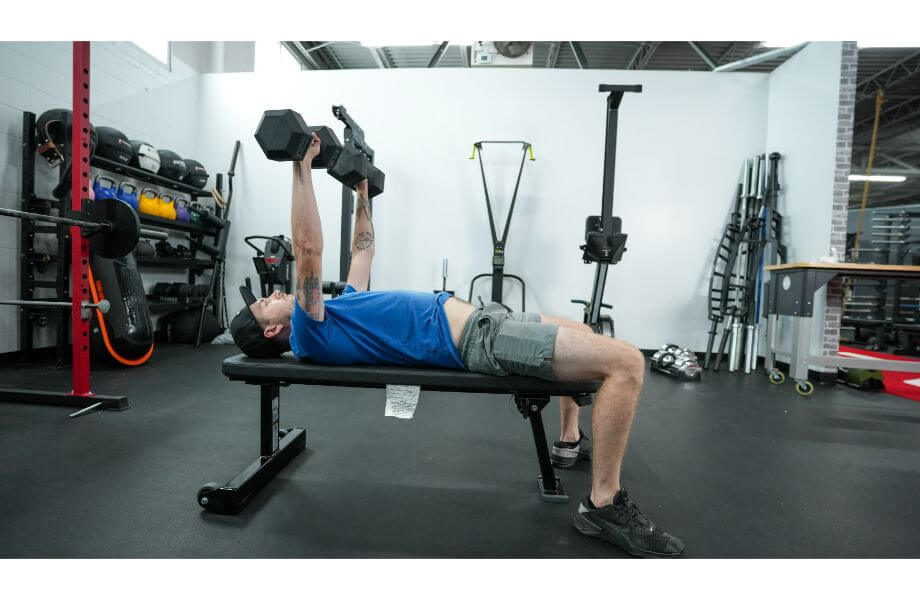
The weekly workout routine is broken down as follows:
- 1 slow, long-distance workout for both running and swimming
- 1 continuous high-intensity workout for both running and swimming
- 1 interval workout for both running and swimming
- 4 to 5 calisthenics routines
- 2 to 3 upper-body strength training sessions
- 2 to 3 lower-body strength training sessions
- 4 to 5 core exercise routines
- Daily flexibility routines
- Injury prevention exercises as needed
Mixing cardio, strength training, and bodyweight exercises in this fashion should improve your overall fitness while placing special emphasis on the skills you’ll need during the entrance exam.
RELATED: Benefits of Strength Training
Navy SEAL Workout Program
Without further ado, here is the Navy SEAL workout!
Running
The Navy’s recommendations for running are separated into two distinct categories:
1. Steady-State Cardio Training
Steady-state cardio refers to running or performing other cardio exercises at a consistent pace from start to finish. Our Navy SEAL workout program will include two sessions of steady-state cardio—one long slow distance (LSD) run; and one continuous high-intensity (CHI) run for a considerably shorter distance and duration.
For the LSD run, the goal is to move at a manageable pace for approximately 40 to 90 minutes. LSD running is designed to condition the body, minimizing the intensity of the stress you’re placing on your muscles, joints, and glycogen stores while improving muscular endurance and VO2 max.
We recommend using the “Talk Test”2 to gauge your effort level during your LSD run. You should be able to speak in short sentences while maintaining your pace. Ultimately, you will want to be capable of completing five to six miles without stopping or significantly slowing your pace.
For your CHI run, the intensity will be much greater. The Navy itself recommends, on a scale of one to ten, performing in the range of an eight or a nine; so, it’s not an all-out sprint, but it should be quite taxing.
Your CHI sessions should last approximately fifteen to twenty minutes at a time and be followed up with an appropriate cool down activity like a slow jog or brisk walk. Initially, aim to complete one CHI run weekly, but scale to two or three reps of the run as you progress.
RELATED: Best Long-Distance Running Shoes

2. Interval Cardio Training
In addition to your steady-state training, there should also be one interval workout. If you already are familiar with HIIT, you will be well-prepared for this portion of the workout.
The Navy recommends running a quarter-mile at a time, then working with a 1:2 or 1:2.5 work-to-rest ratio. To translate, that means if you take two minutes to complete a quarter-mile run, you should rest for between four and five minutes before your next interval.
RELATED: How to Use a Treadmill for Interval Training
As a baseline, complete a 1.5-mile run and push to run at a pace that is slightly faster for your quarter-mile intervals. Then, try to outdo yourself on each interval.
You definitely don’t have to demolish your current best every time but aim to shave a few seconds off or, at the very least, stay within a few seconds. If your time starts really going off the rails, you’ll need to stop and take a real breather before continuing.
Start out the routine by completing four intervals per weekly HIIT session, but progressively scale to ten as you improve.
Swimming
You might feel like a fish out of water if you don’t have some prior swimming experience.
We recommend taking swimming lessons to perfect your technique before attempting any training protocol that requires swimming at a high volume or intensity. The BUD/S entrance exam only allows breaststroke or sidestroke, so prioritize finetuning your technique with these strokes.
RELATED: Best Waterproof Headphones
1. Steady-State Cardio Training
The Navy’s recommended volume for swimming is identical to the running requirements in that you must complete one LSD and one CHI swim.
For the LSD swim, the goal again is to move for between 40 and 90 minutes for your one weekly session, shooting to complete approximately one to one-and-a-half miles.
For the CHI swim, aim to swim at a pace that’s only slightly below an all-out sprint and be ready to sustain it for approximately fifteen to twenty minutes.
2. Interval Cardio Training
Your swimming intervals will also be similarly structured to the running portion of the weekly workout routine.
For a baseline, complete a 500-yard swim and aim to swim at a pace that’s two seconds faster for your intervals. As for distance, 100 yards at a time is the standard.
Your work-to rest-ratio should again be 1:2 or 1:2.5, and remember—the difference between your fastest interval and slowest interval should not be drastic. If you’re going hard in the beginning and during the final push but losing steam in the middle, you should adjust your pace for every interval to maintain consistency.
Start out the training program with four intervals, gradually adding one as your abilities improve, but never exceed ten intervals per session.
Calisthenics
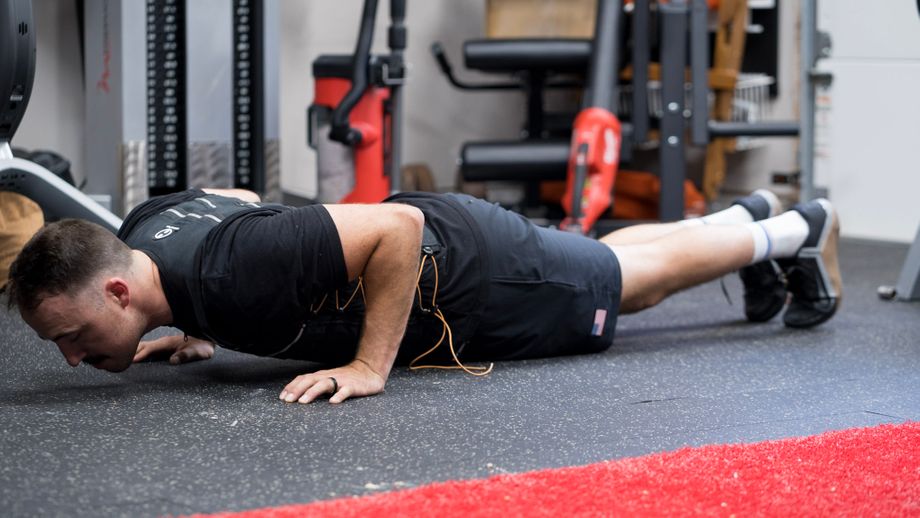
If you’re going to train like a Navy SEAL and stand your best chance to smash the BUD/S entrance exam, you’ll want to perfect your pull-ups, push-ups, and sit-ups.
It’s recommended to complete calisthenic exercises four to five times during the week, so it’s your decision if you’d like to do them before the cardio or get it in at the end.
RELATED: How to Program Your Own Home Workouts
You don’t have to do pull-ups, push-ups, and sit-ups all in one day for each session, though. It’s totally fine to focus on pull-ups one day, push-ups the next, and sit-ups the next for a three-day split of the required exercises.
Pull-Ups
Performing a single pull-up is a milestone for many fitness enthusiasts, so it’s a godsend that you’ll only need to crank out ten reps on the day of the fitness test. It’s also the only portion of the test in which a time limit is not imposed, which further works in your favor.
Thankfully, the Navy provides an excellent table to help you structure a pull-up workout plan that works for you. Before your calisthenic fitness training truly starts, perform a set of pull-ups until you reach muscle failure to set a baseline.
Once you have your baseline, follow this chart to determine the rep scheme that’s best suited to your fitness level.
| Baseline | Sets | Reps | Total |
| Less than 6 | 5 to 6 | 2 to 3 | 10 to 18 |
| 6 to 9 | 4 to 5 | 4 to 5 | 16 to 25 |
| 10 to 12 | 4 to 5 | 5 to 6 | 20 to 30 |
| 13 to 15 | 3 to 4 | 8 to 10 | 24 to 40 |
| Greater than 15 | 3 to 4 | 10 to 12 | 30 to 48 |
Push-Ups
The PST will require you to perform fifty push-ups in under two minutes. Although the goal is to get them done as quickly as possible, proper form is required, so you should train to make sure each rep is slow and controlled through the range of motion.
As with your pull-up training, perform a set of push-ups until you reach muscle failure, record that as your baseline, and follow the chart below for your personalized push-up workout.
| Baseline | Sets | Reps | Total |
| Less than 40 | 5 to 6 | 10 to 15 | 50 to 90 |
| 40 to 60 | 4 to 5 | 15 to 20 | 60 to 100 |
| 60 to 80 | 4 to 5 | 20 to 25 | 80 to 125 |
| 80 to 100 | 3 to 4 | 30 to 40 | 90 to 160 |
| Greater than 100 | 3 to 4 | 40 to 50 | 120 to 200 |
Sit-Ups
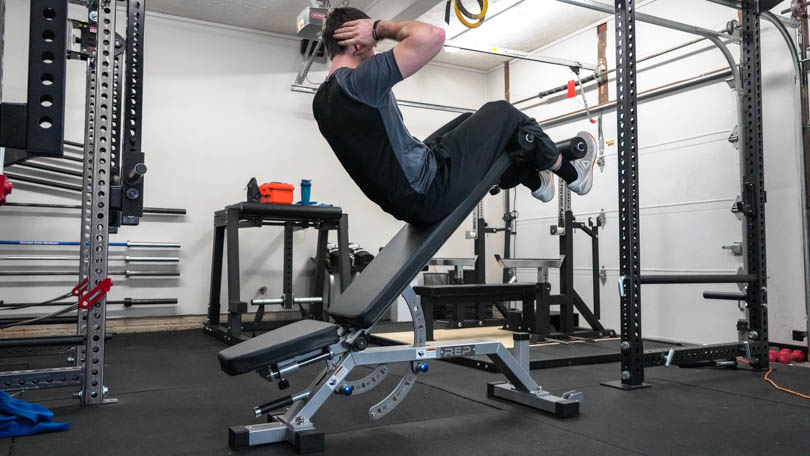
The PST also requires you to perform fifty sit-ups with perfect form in under two minutes.
Warm-up with crunches, perform the biggest set of sit-ups to establish your baseline, and follow the chart to determine your personalized sit-up plan.
| Baseline | Sets | Reps | Total |
| Less than 40 | 5 to 6 | 10 to 15 | 50 to 90 |
| 40 to 60 | 4 to 5 | 15 to 20 | 60 to 100 |
| 60 to 80 | 4 to 5 | 20 to 25 | 80 to 125 |
| 80 to 100 | 3 to 4 | 30 to 40 | 90 to 160 |
| Greater than 100 | 3 to 4 | 40 to 50 | 120 to 200 |
Weight Training
Bodybuilding exercises like the bench press, back squat, and deadlift are great for building an all-around impressive foundation, but they’re not the only strength training movements suggested to get in peak physical condition.
RELATED: Deadlift Muscles Worked
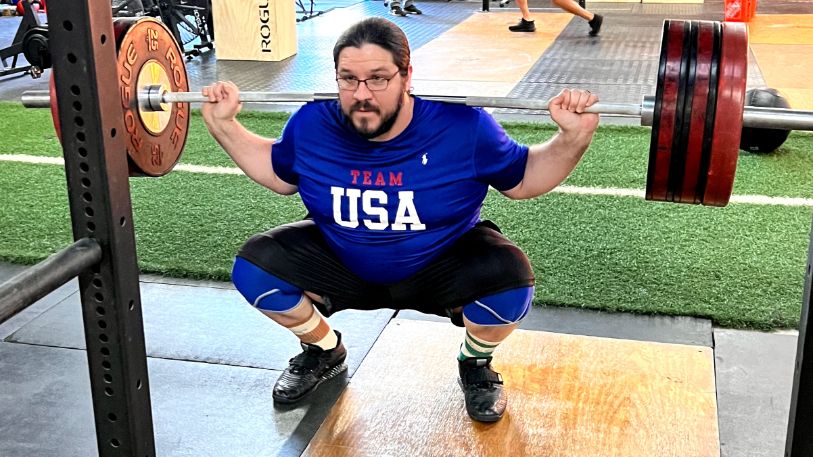
For an upper-body workout, which should be completed two or three times weekly, consider some of the below-recommended exercises:
- Lat pulldown
- Military press
- Barbell bench press
- Incline bench press
- Seated row pull
- Dumbbell lateral raise
- Upright row
- Triceps extension
- Bodyweight or weighted dips
A single set containing eight to twelve reps is sufficient for this portion of the workout, considering the additional volume you’re getting from running, swimming, and calisthenics.
The same rep scheme and structure applies to your lower-body workout, which, too, should be completed two to three times weekly. Exercises include:
- Lunges
- Leg curls
- Back hyperextensions
- Deadlifts
- Back squats
- Leg press
- Heel raises
The Navy recommends taking little to no rest between each exercise you are performing in order to maximize the intensity of the workout and ultimately reap greater enhancements to your cardiovascular system.
Performing the duties of a Navy SEAL is incredibly taxing, so it makes sense the training should be similarly exhausting to better simulate a day in the life of the elite Navy SEAL team.
RELATED: The Best Olympic Barbells For 2023
Rucking
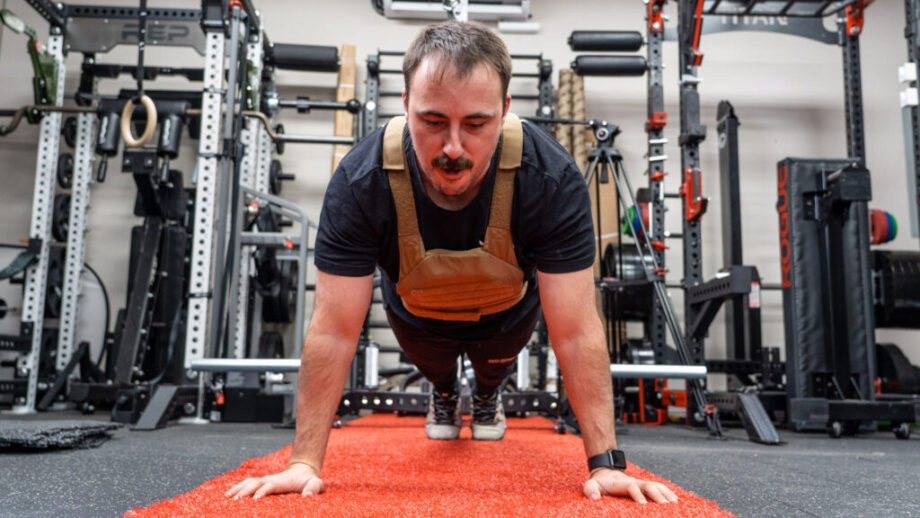
While the NSW does not specifically mention rucking, it’s a known fact that military cadets and officers alike must regularly carry their gear for long periods across long distances. Sometimes, the gear can weigh nearly fifty pounds!
To prepare, consider adding a day in which you go for a long hike carrying a weighted backpack or wearing a weighted vest to simulate the demands of boot camp and Navy SEAL training.
You do not have to run while wearing the pack, but a moderate to strenuous hike should suffice.
Navy SEAL Workout: Final Thoughts
If you’re going to survive BUD/S training, including the infamous Hell Week, it pays to train like a Navy SEAL well before the actual special forces training begins.
It requires a multifaceted approach, including running, swimming, calisthenics, weightlifting, and more, but it will be well worth it when the rigorous training feels just a bit easier.
So, whether you’re looking to build muscle, burn fat, encourage weight loss, or you truly want to be one of the elite few worthy of wearing the Navy SEAL Trident insignia, try out our Navy SEAL workout, and you’ll be well on your way!
RELATED: 7 Workout Programs For Veterans
Navy SEAL Workout: FAQs
How do Navy SEALs train?
Navy SEALs train extensively after passing the BUD/S entrance exam. The workouts include elements of steady-state cardio, continuous high-intensity cardio, HIIT, calisthenics exercises, weightlifting, and more.
To properly prepare, you’ll need a well-rounded approach that targets most or all of the major muscle groups in the body, as well as plenty of cardio to build your engine.
How hard is it to become a Navy SEAL?
It is extremely difficult to become a Navy SEAL. Only about 25 to 35% of candidates ever complete the training and earn the insignia.
What kind of workouts do Navy SEALs do?
Navy SEAL workouts include running, swimming, calisthenics, weightlifting, and more.
How many hours a day do SEALs train?
The amount of hours Navy SEALs train varies depending on the phase of the BUD/S training program. Hell Week, which occurs in Week 4, is renowned for being the most brutal. Candidates get only four hours of sleep during this week, training for the other twenty waking hours.
Very few candidates remain enrolled in BUD/S following this make-or-break week.
These statements have not been evaluated by the Food and Drug Administration. This product is not intended to diagnose, treat, cure, or prevent any diseases.
References
1. Naval Special Warfare Physical Training Guide. Accessed July 19, 2023. https://navyseals.com/wp-content/uploads/2012/12/naval-special-warfare-physical-training-guide.pdf.
2. Saini M, Kulandaivelan S, Devi P, Saini V. The talk test-A costless tool for exercise prescription in Indian cardiac rehabilitation. Indian Heart J. 2018;70 Suppl 3(Suppl 3):S466-S470. doi:10.1016/j.ihj.2018.09.009


